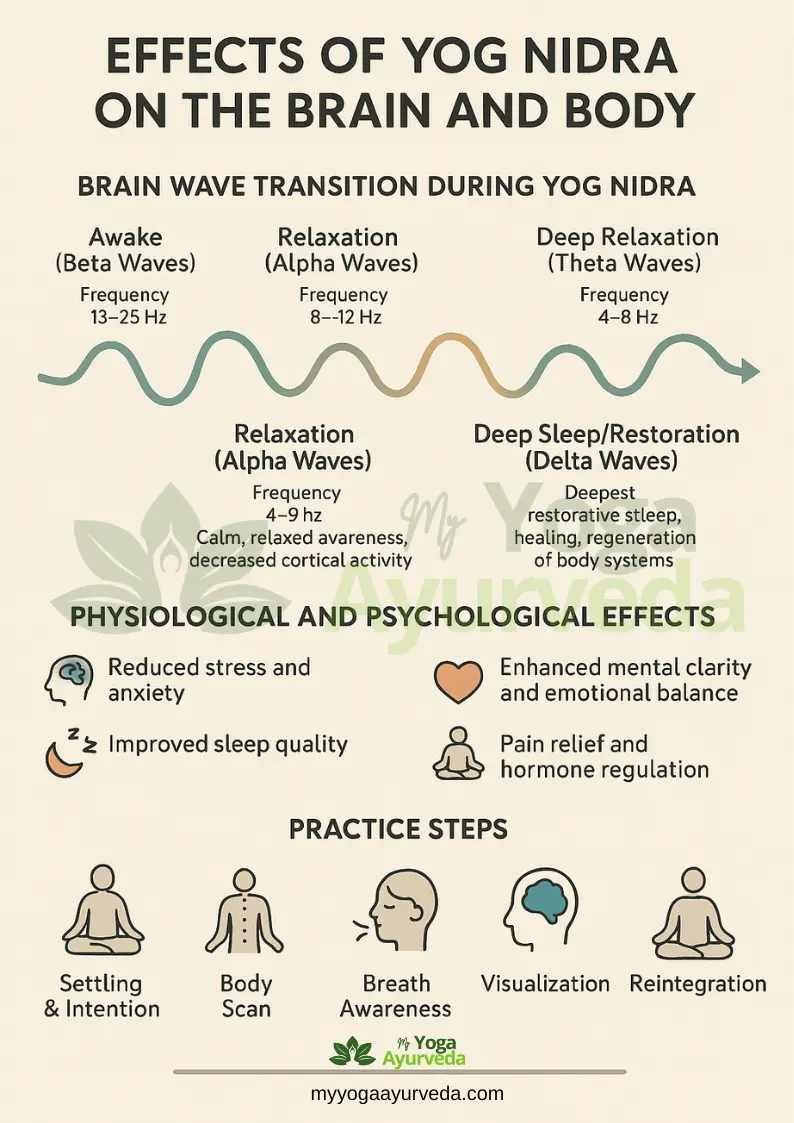
Written by Yoga Mentor Keshav, with facts sourced from Ancient Indian Ayurvedic and Yogic Textbooks, as well as scientific research.
Yog Nidra, often called ‘yogic sleep,’ is a guided meditation technique rooted in ancient yogic traditions.
Unlike regular sleep, Yog Nidra helps you enter a conscious state between wakefulness and sleep, allowing the body and mind to relax deeply while maintaining awareness. Here’s a closer look at what Yog Nidra is, how to do Yog Nidra, and the range of science-backed benefits associated with the practice.
Yoga Nidra means “conscious sleep.” It is a state between sleep and wakefulness where you’re deeply relaxed yet aware. This is a condition of inner awareness where we connect with our subconscious and higher consciousness.
Yoga Nidra helps in total personality renewal. It energizes people who tend to be lazy or dull. During Yoga Nidra, the awareness of physical body centers turns inward — this inward withdrawal is called Pratyahara.
When the mind focuses on one point, the breath, pranic energy, and even sensory organs also focus there. This leads to deep relaxation, tension release, and mental clarity.
A typical Yog Nidra session involves several stages:
Settling the Mind and Body for Practice
→ Settle into stillness as we prepare the body and mind for deep inner rest.
Positive Sankalpa (संकल्प)
→ Plant a powerful, positive intention in your subconscious mind.
Body Awareness (शरीर का विश्राम)
→ Systematically relax every part of your physical being.
Breath Awareness (साँस की सजगता)
→ Deepen your connection to your breath for profound calm.
Awareness of Emotions & Feelings (भावनाओं एवं संवेदनाओं की जागरूकता)
→ Observe emotions as passing clouds — acknowledge them without attachment.
Remember Sankalpa (संकल्प)
→ Recall your powerful intention and reaffirm it deeply within.
Returning to the Body (शरीर में वापसी)
→ Gently guide your awareness back to the physical body and outer world, refreshed and centered.
Deep Relaxation & Integration
→ Sink into a state of blissful mental and physical rest.
In this state, we connect with our deeper self. It helps us change our attitudes towards ourselves and others. This is called self-observation (Atma-Nirikshan). Many yogis have used this method since ancient times to connect with their true self.
Yoga Mentor Keshav offers a clear and calming 15-minute Yoga Nidra practice. This guided meditation walks you through each stage, helping you relax fully while staying aware. You can follow along with his session here: 15-Minute Yoga Nidra for Deep Rest by Yoga Mentor Keshav.
What is Yoga? A Comprehensive Guide to Understanding Yoga and Its Benefits →
Yog Nidra offers more than just relaxation—it’s also been studied as a therapeutic technique, with findings published in respected medical and scientific journals.
Improves Sleep and Helps with Insomnia
A 2023 clinical study on Yog Nidra in the Journal of Integrative and Complementary Medicine demonstrated that regular practice helped participants fall asleep faster and improved overall sleep quality, especially for those with insomnia. The researchers concluded that Yog Nidra effectively activates the body’s “rest and digest” response, supporting healthy sleep cycles. See the published study here.
Reduces Anxiety and Stress
According to scientific research in the International Journal of Yoga, regular Yog Nidra practice can lower anxiety, even in people with chronic conditions like hypertension. These benefits are linked to reduced cortisol (the body’s primary stress hormone) and improved nervous system balance. Read the full research article.
Enhances Mental Clarity and Emotional Stability
A study featured in Frontiers in Human Neuroscience highlights that Yog Nidra boosts cognitive flexibility and emotional self-regulation. Many participants reported better mood, improved focus, and increased ability to manage emotional responses—even after just a few sessions. Learn more from the neuroscience study.
Supports Heart and Manages Type-2 Diabetes
The same International Journal of Yoga study also found that Yog Nidra reduces both systolic and diastolic blood pressure, as well as heart rate—positive effects for cardiovascular health.
7 Simple Ways to Keep Your Heart Healthy (Backed by Science) →
Additional clinical research shows that ongoing practice can help improve blood sugar metabolism and insulin sensitivity, making it helpful for managing Type 2 diabetes. View the latest metabolic research.
Eases Chronic Pain and Fibromyalgia
A 2022 pain management study reported that people living with chronic pain or fibromyalgia experienced less pain and fatigue after regular Yog Nidra sessions. The authors link these benefits to increased body awareness and calming breathwork, which quiet pain signals in the nervous system. Read the chronic pain study.
Improves Hormonal Balance and Immune Function
Clinical evidence published in 2020 shows that Yog Nidra can balance hormones like cortisol and melatonin, supporting a healthy immune response, regular menstrual cycles, and greater overall vitality. See the clinical results here.

Supports Trauma and PTSD Recovery
Research featured in the Journal of Traumatic Stress demonstrates that trauma survivors—including veterans using iRest (a modern Yog Nidra method)—reported fewer PTSD symptoms, better sleep quality, and increased emotional resilience. Find the PTSD and trauma study here.
Boosts Overall Wellbeing and Life Satisfaction
Ongoing academic research, including large-scale studies, consistently finds that regular Yog Nidra practice is linked to higher psychological well-being, greater satisfaction with life, and improved resilience. The relaxation and self-awareness developed through Yog Nidra are primary reasons for these improvements. Explore a recent wellbeing study. See additional evidence here.
Q1. Is Yog Nidra the same as sleep?
No. In Yog Nidra, you remain aware while your body enters a restful state. In normal sleep, this awareness disappears.
Q2. How often should I practice Yog Nidra?
You can practice Yog Nidra daily, or at least two to three times a week. Even sessions of 15–30 minutes can be beneficial over time.
Q3. Can beginners try Yog Nidra?
Yes. No prior experience is needed. Lie down, follow along, and try to relax.
Q4. Is it safe for everyone?
For most people, Yog Nidra is safe at any age. Those with severe psychiatric illnesses should first consult a mental health professional.
Q5. What’s the best time to practice Yog Nidra?
While you can practice any time, many find it especially helpful before sleep or in the afternoon to counteract stress and tiredness. But the best time is at night before Sleep.
Yoga Nidra is a powerful relaxation technique that supports overall health and well-being. Backed by scientific research, it helps reduce stress, improve sleep, and support recovery from chronic health issues. Whether you’re dealing with anxiety, sleep problems, or just want to feel more peaceful and focused, regular practice of Yoga Nidra can bring real, lasting benefits to your mind and body.
Explore a guided session: Watch Yog Nidra by Keshav on YouTube


